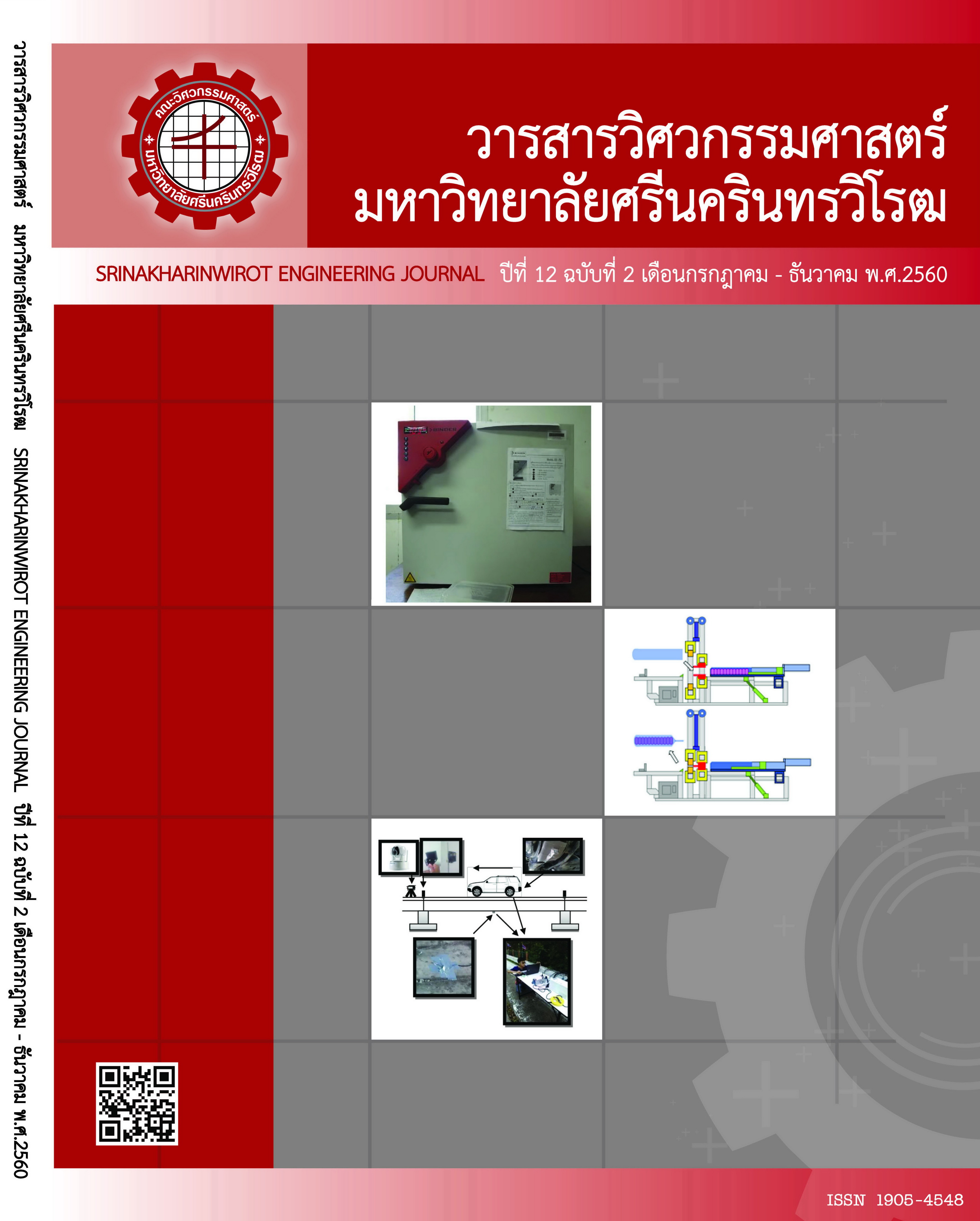การหาสมการความสัมพันธ์ระหว่างสมรรถนะของอีเจ็คเตอร์กับเงื่อนไขการทำงานและรูปร่างของอีเจ็คเตอร์โดยใช้วิธีแบบโครงร่างพื้นผิว
Main Article Content
บทคัดย่อ
งานวิจัยนี้เป็นการศึกษาอิทธิผลของปัจจัยที่มีผลต่อสมรรถนะของอีเจ็คเตอร์ในระบบทำความเย็นแบบอีเจ็คเตอร์ ซึ่งได้แก่ อิทธิพลจากเงื่อนไขการทำได้ ได้แก่ อุณหภูมิของเครื่องกำเนิดไอ อุณหภูมิเครื่องระเหย และ อิทธิพลของรูปร่าง อีเจ็คเตอร์ ได้แก่ อัตราส่วนพื้นที่หน้าตัดของคอคอดหัวฉีดกับห้องผสม (Area ratio, AR) และอัตราส่วนพื้นที่หน้าตัดปากทางออกกับคอคอดของหัวฉีด (Area of throat ratio, ATR) โดยศึกษาด้วยระเบียบวิธีพลศาสตร์การไหลเชิงคำนวณ (Computational Fluid Dynamics, CFD) วางแผนการศึกษาด้วยวิธี Central Composite Design (CCD) และทำการวิเคราะห์ผลของปัจจัยต่างๆเหล่านั้น ต่ออัตราส่วนการเหนี่ยวนำ (Entrainment ratio, Rm) และความดันทางออกวิกฤต (Critical back pressure, CBP) ของอีเจ็คเตอร์ ด้วยวิธีแบบโครงร่างพื้นผิว (Response Surface Methodology, RSM) เพื่อหาสมการถดถอย (Regression equation) จากผลการศึกษา พบว่า สภาวะการทำงานและรูปร่างของอีเจ็คเตอร์มีอิทธิพลต่อสมรรถนะของอีเจ็คเตอร์อย่างมีนัยสำคัญ นอกจากนี้ การสร้างความสัมพันธ์ในรูปแบบเชิงเส้นโค้ง (Quadratic model) มีความเหมาะสม โดยมีระดับความเชื่อมั่นที่ 95% แต่อย่างไรก็ตาม ค่าความดันทางออกวิกฤตที่ได้ยังมีค่าเบี่ยงเบนจากการทดลองอยู่เล็กน้อยเพราะมีหลายปัจจัยที่ไม่ได้พิจารณาในการศึกษานี้
Article Details
ลิขสิทธิ์เป็นของวารสารวิศวกรรมศาสตร์ มหาวิทยาลัยศรีนครินทรวิโรฒ
เอกสารอ้างอิง
[2] J. H. Keenan and E. P. Neumann, “A simple air ejector,” Transactions of the ASME Journal of Applied Mechanics, vol. 64, pp. 75-81, 1942.
[3] J. H. Keenan, E. P. Neumann and F. Lustwerk, “An investigation of ejector design by analysis and experiment,” Transactions of the ASME Journal of Applied Mechanics, vol. 72, pp. 299 – 309, 1950.
[4] J. T. Munday and D. F. Bagster, “A new theory applied to steam jet refrigeration,” Industrial & Engineering Chemistry Process Design and Development, vol. 16(4), pp. 442-449, 1997.
[5] S. B. Riffat and S. A. Omer, “CFD modeling and experimental investigation of an ejector refrigeration system using methanol as the working fluid,” International Journal of Energy Research, vol. 25, 115-128, 2001.
[6] K. Pianthong, W. Seehanam, M. Behnia, T. Sriveerakul and S. Aphornratana, “Investigation and improvement of ejector refrigeration system using computational fluid dynamics technique,” Energy Conversion and Management, vol. 48, pp. 2556–2564, 2007.
[7] T. Sriveerakul, S. Aphornratana and K. Chunnanond, “Performance prediction of steam ejector using computational fluid dynamics: Part 1. Validation of the CFD results,” International Journal of Thermal Sciences, vol. 46, pp. 812–822, 2007.
[8] T. Sriveerakul, S. Aphornratana and K. Chunnanond, “Performance prediction of steam ejector using computational fluid dynamics: Part 2. Flow structure of a steam ejector influenced by operating pressures and geometries,” International Journal of Thermal Sciences, vol. 46, pp. 823–833, 2007.
[9] G. Besagni, R. Mereu and F. Inzoli, “Ejector refrigeration: A comprehensive review,” Renewable and Sustainable Energy Reviews. Vol. 53, pp. 373-407, 2016.
[10] N. Ruangtrakoon, S. Aphornratana, and T. Sriveerakul, “Experimental studies of a steam jet refrigeration cycle: Effect of the primary nozzle geometries to system performance,” Experimental Thermal and Fluid Science, vol. 35, pp. 676–683, 2011.
[11] K. Chunnanond. and S. Aphornratana “An experimental investigation of a steam ejector refrigerator: the analysis of the pressure profile along the ejector,” Applied Thermal Engineering, vol. 24,pp.311-322, 2004.


